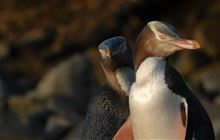Rock lobster levels in Taputeranga Marine Reserve
Introduction
How many rock lobster (crayfish/kōura) are present in Taputeranga Marine Reserve and how are their numbers changing?Total number of rock lobster inside and outside Taputeranga Marine Reserve
Download the data used in the graph (XLXS, 15K)
See research and monitoring for information about how this data was collected.
Status: undetermined
Since the creation of Taputeranga Marine Reserve, rock lobster (crayfish/kōura) have become larger, heavier and more plentiful inside the marine reserve than outside its boundaries. Because the natural level of rock lobster in the marine reserve is uncertain, the health status of this species cannot be assessed at this time.
Wellington’s south coast is popular with fishers. Marine reserves have no walls, so rock lobster may be caught if they move outside the marine reserve.
Trend: undetermined
The number and average size of rock lobster inside Taputeranga Marine Reserve increased and decreased in the last 4 years of monitoring, so a trend has not been given.
By preventing fishing and other disturbance, a marine reserve enables an area of sea and shore to return to a more natural state. Research in other marine reserves has shown that the full benefit of protection can usually be seen after 10 years or more. The data from Taputeranga Marine Reserve currently covers 5–8 years of protection, so future studies may show more positive effects such as larger and more plentiful rock lobster.
Reports
- Positive effects of full no-take protection on rock lobster (Jasus edwardsii) populations in two central New Zealand marine reserves. Rojas-Nazar et al, 2017. Unpublished data, manuscript in submission.
- Lobsters as keystone: only in unfished ecosystems? Eddy et al, 2014.
- A baseline biological survey of the proposed Taputeranga Marine Reserve (Wellington, New Zealand): spatial and temporal variability along a natural environmental gradient. Pande and Gardner, 2009.

